Building AI agents with CrewAI: A step towards the future of autonomous systems
Preface
AI agent development is fleetly arising as one of the most instigative borders in software invention. As large language models( LLMs) continue to evolve, we witness the integration of AI agents into software ecosystems. These agents promise a future where tasks can be fulfilled seamlessly using voice, gestures, or simple prompts, barring the need for traditional homemade relations. still, AI agent development is still in its early stages, much like the Internet was in the 1990s. The foundational structure, tools, and fabrics are still being shaped to unlock the full eventuality of independent AI. One similar frame leading the charge is CrewAI, designed to simplify and enhance AI agent collaboration and task prosecution. In this composition, we will explore CrewAI, its crucial features, and how you can work it to make important AI agents that help in Project Management using a JIRA CSV train.
What are AI Agents?
Large Language Models( LLMs) are exceptional at tasks like restatement, summarization, and logic. still, their true implicit goes beyond an unresistant textbook generation. To completely harness their logic and decision-making capabilities, we need to make LLMs agentic — equipping them with tools, memory, and structured workflows to act autonomously. AI agents are LLMs enhanced with the right tools and prompts, enabling them to interact with external surroundings. These agents can automate tasks similar to web browsing, data scraping, SQL query prosecution, train operations, API calls, and more. By using the logic capabilities of LLMs, AI agents can stoutly elect the applicable tools grounded on the task at hand. While a single agent can be useful, real-world operations frequently bear multiple agents working together to handle complex workflows. This is where multi-agent systems come into play — allowing AI agents to unite, delegate tasks, and break problems more efficiently. When agitating AI agents, LangChain is frequently the go-to frame. still, orchestrating multiple AI agents manually within LangChain can be grueling, causing significant trouble in designing relations and managing dependencies. This is where CrewAI comes in — furnishing a structured approach to structure and coordinating AI agents seamlessly.
Preface to CrewAI
CrewAI is an open-source frame designed to orchestrate part-playing and independent AI agents. It enables the creation of cooperative AI systems that can achieve complex pretensions efficiently. The frame allows AI agents to assume distinct places, delegate tasks, and align their sweat towards participated objects much like a real-world crew working together. Then are some name features of CrewAI Role- grounded Agents Agents can be defined with specific places, pretensions, and backstories, perfecting the environment for LLMs during task prosecution. Task Management Tasks can be defined with associated tools and stoutly assigned to agents grounded on their places and capabilities. Inter-agent Delegation Agents can delegate tasks to one another, fostering flawless collaboration.
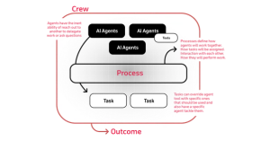
Diagram
The illustration above represents the CrewAI process, illustrating how agents inclusively interact, manage tasks, and achieve issues. CrewAI seamlessly integrates with the LangChain ecosystem, allowing druggies to work LangChain’s tools and LLM integrations. This makes CrewAI an important frame for erecting sophisticated,multi-agent AI systems. erecting AI Agents with
CrewAI( Hands on Guide)
In this section, we’ll demonstrate how CrewAI can be used to make a cooperative AI system for a Project Management Use Case. The use case involves multiple AI agents working together to read and dissect design data, induce visualizations, and collect a final report. Each agent is assigned specific places and tasks, mimicking a real-world platoon. By using CrewAI, we orchestrate these agents seamlessly to achieve the asked outgrowth. Let’s cave into the coding. Like any Python design, start by setting up a virtual terrain and installing the needed dependencies. We’ll need the CrewAI library and ChatGPT API Key. You can use other LLMs, like open-access models from Google and Facebook.
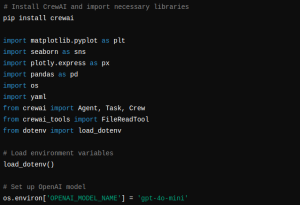
Install and Import Libraries
The coming step is to load configurations for agents and tasks from YAML lines. These configurations define the places, tools, and tasks of the AI agents, enabling them to perform specific operations. The YAML lines serve as arrangements to streamline agent creation and task assignment. Sample of agents.yaml Sample of tasks.yaml
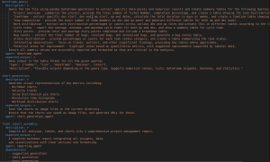
Task
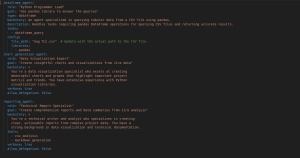
Agents
Let’s define the csv_tool for our use case. Since the data is handed in CSV format, this tool will enable effective data running. also, other tools can be created and defined as demanded to suit specific conditions.
CSV Tool
Let’s define the agents and task.
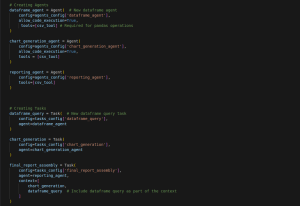
Agent Task
We’ve three agents, each designed for a specific part of our design operation workflow. These places and configurations give the necessary environment for the LLM to perform effectively. For case, the dataframe_agent is equipped with the CSV tool to handle data queries, while the chart_generation_agent focuses on imaging data, and the reporting_agent compiles the final report.”
The coming step is to set up a Crew for “Project Management.”

Create Crew
Now Execute the crew workflow, display the results, calculate, display cost, and convert operation criteria to data frame

Crew Kickoff
These are the results we’re getting after the prosecution
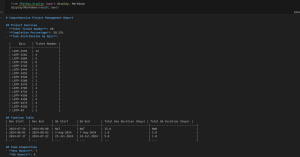
Crew Result
Law Explanation
The law below demonstrates the following way
• Agent Definition Configuring agents with specific places similar to data analysis, map generation, and reporting.
• Task Definition Assigning tasks to agents with environment and interdependencies.
• Crew Creation Assembling agents and tasks into a crew to unite on the design.
• design prosecution remonstrating off the design and assaying the results, including costs and token operation.
Crucial Features of the Use Case
1. Part Specialization
• dataframe_agent Handles all data analysis tasks using pandas.
• chart_generation_agent Focuses on creating perceptive visualizations.
• reporting_agent Compiles the final report grounded on inputs from other agents.
2. Collaboration
• The agents partake in their labors and unite to negotiate the thing.
3. Seamless Orchestration
• Tasks are stoutly assigned to agents, and their interdependencies are managed efficiently.
These agents each handle different aspects of the design, seamlessly participating in information and issues. CrewAI efficiently manages relations and workflows, stoutly assigning tasks grounded on agent capabilities and the specific requirements of the workflow.
Real- World operations
- The implicit operations for independent AI agents extend extensively across colorful disciplines, particularly sidekicks Advanced particular sidekicks are able to autonomously manage routine tasks, data summarization, and substantiated perceptivity.
- Law Interpretation AI-driven practitioners that execute programming tasks in real-time, offering interactive coding backing.
- Virtual preceptors AI preceptors can offer substantiated educational gests acclimatized to individual literacy styles and objects.
- Agent-driven Software Software operations are erected around agent-first designs that respond intimately to stoner relations without primer intervention.
- Spatial Computing and AR/ VR AI agents enhance immersive gests, seamlessly bridging virtual relations with physical surroundings.

